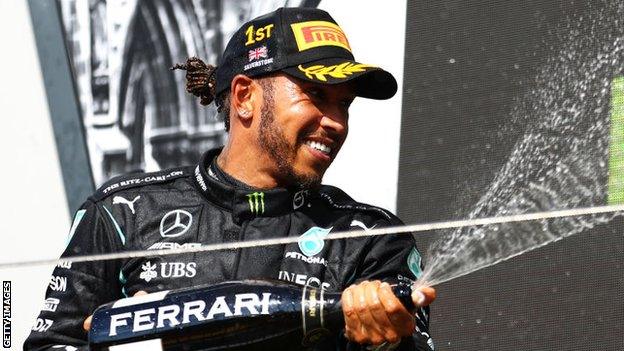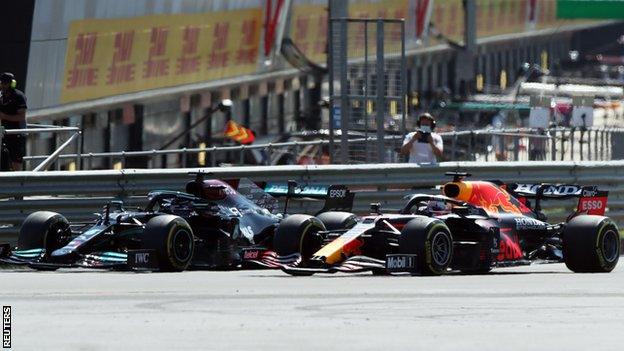Lewis Hamilton: Penalty for collision with Max Verstappen 'harsh', says Mercedes chief
- Published

Lewis Hamilton fought back from a 10-second penalty to claim a dramatic British Grand Prix victory on Sunday
The penalty Lewis Hamilton received for his collision with Max Verstappen in the British Grand Prix was "harsh", according to his Mercedes team.
James Allison, Mercedes chief technical officer, says Hamilton followed Formula 1's overtaking rules in the incident.
"There was no need for him to cede any ground so I did feel that it was harsh to get the penalty," said Allison.
"As far as we are concerned, the manoeuvre Lewis did was absolutely in line with the FIA's overtaking guide."
Hamilton was adjudged by race stewards to have been "predominantly to blame" for the incident at Copse corner, which resulted in Verstappen, 23, being taken to hospital after a 51G impact.
The seven-time world champion was given a 10-second penalty, which dropped him from second to fourth at his pit stop. Hamilton, 36, recovered to pass Ferrari's Charles Leclerc for victory with two laps to go and cut Verstappen's championship lead to eight points.
Red Bull team principal Christian Horner angrily said "the move was never on", and called Hamilton's passing attempt "desperate", "ill-judged" and "amateur".

Hamilton and Verstappen were wheel-to-wheel racing before Verstappen was sent into the wall at Copse corner
But Allison said the FIA's own guidelines for race stewards gave Hamilton the right to make the attempt and not give way to Verstappen.
In a video released by Mercedes reviewing the British Grand Prix weekend, he added: "If you are overtaking on the inside of the corner, then the guidance requires that you are substantially alongside as you arrive at the corner. It is not required that you are ahead.
"Lewis was definitely substantially alongside. He had his front axle well beyond the midpoint of Verstappen's car.
"And it requires that you must be able to make the corner. By 'make the corner', it means go round the corner and not leave the track or lose control of the car.
"If you can go round the corner, if you are substantially alongside the other car, then the corner is yours.
"What that means is not that you have to emerge in the lead; it means that you do not have to cede your position, you do not have to back off and the other car has a duty to avoid hitting you.
"So, if you follow the notes that are provided to the FIA stewards and you look frame by frame at what happened with Lewis, he was substantially alongside, he absolutely would have made the corner and indeed did make the corner and therefore there was no need for him to cede any ground."
Allison added the speed of Copse corner, which is taken at 190mph in an F1 car, "makes no difference". "Lewis made two further overtakes at Copse using exactly the same guidance and there wasn't a contact in either of those cases," he said.
Opinion from current and former drivers on the incident has been split.
Two-time champion Fernando Alonso and Leclerc both said it was a 'racing incident' in which neither driver was more to blame than the other.
But ex-F1 drivers Mark Webber and David Coulthard both said in their roles as Channel 4 pundits that Hamilton was at fault.
In their ruling, the stewards mentioned Hamilton "did not reach the apex of the corner, with room available to the inside" and "did not avoid contact".
But Allison said: "I can understand people, who maybe don't understand there is no obligation on you to hit the apex of the corner, that you don't have to have your whole car in front of the other car.
"I can understand that, if you are seeing it from that perspective, you might think that the car coming from behind has some sort of obligation to make sure that no crashes take place. But if you look at the stewarding document then I think that Lewis did nothing wrong."

Gold Rush: How Britain's Olympic dreams were rebuilt after a disappointing 1996
An exclusive BBC News special: Dominic Cummings is interviewed on his role in Brexit, the pandemic and the government

